Qiushi Sun
CapArena: Benchmarking and Analyzing Detailed Image Captioning in the LLM Era
Mar 16, 2025Abstract:Image captioning has been a longstanding challenge in vision-language research. With the rise of LLMs, modern Vision-Language Models (VLMs) generate detailed and comprehensive image descriptions. However, benchmarking the quality of such captions remains unresolved. This paper addresses two key questions: (1) How well do current VLMs actually perform on image captioning, particularly compared to humans? We built CapArena, a platform with over 6000 pairwise caption battles and high-quality human preference votes. Our arena-style evaluation marks a milestone, showing that leading models like GPT-4o achieve or even surpass human performance, while most open-source models lag behind. (2) Can automated metrics reliably assess detailed caption quality? Using human annotations from CapArena, we evaluate traditional and recent captioning metrics, as well as VLM-as-a-Judge. Our analysis reveals that while some metrics (e.g., METEOR) show decent caption-level agreement with humans, their systematic biases lead to inconsistencies in model ranking. In contrast, VLM-as-a-Judge demonstrates robust discernment at both the caption and model levels. Building on these insights, we release CapArena-Auto, an accurate and efficient automated benchmark for detailed captioning, achieving 94.3% correlation with human rankings at just $4 per test. Data and resources will be open-sourced at https://caparena.github.io.
OS-Genesis: Automating GUI Agent Trajectory Construction via Reverse Task Synthesis
Dec 27, 2024Abstract:Graphical User Interface (GUI) agents powered by Vision-Language Models (VLMs) have demonstrated human-like computer control capability. Despite their utility in advancing digital automation, a critical bottleneck persists: collecting high-quality trajectory data for training. Common practices for collecting such data rely on human supervision or synthetic data generation through executing pre-defined tasks, which are either resource-intensive or unable to guarantee data quality. Moreover, these methods suffer from limited data diversity and significant gaps between synthetic data and real-world environments. To address these challenges, we propose OS-Genesis, a novel GUI data synthesis pipeline that reverses the conventional trajectory collection process. Instead of relying on pre-defined tasks, OS-Genesis enables agents first to perceive environments and perform step-wise interactions, then retrospectively derive high-quality tasks to enable trajectory-level exploration. A trajectory reward model is then employed to ensure the quality of the generated trajectories. We demonstrate that training GUI agents with OS-Genesis significantly improves their performance on highly challenging online benchmarks. In-depth analysis further validates OS-Genesis's efficiency and its superior data quality and diversity compared to existing synthesis methods. Our codes, data, and checkpoints are available at \href{https://qiushisun.github.io/OS-Genesis-Home/}{OS-Genesis Homepage}.
OS-ATLAS: A Foundation Action Model for Generalist GUI Agents
Oct 30, 2024
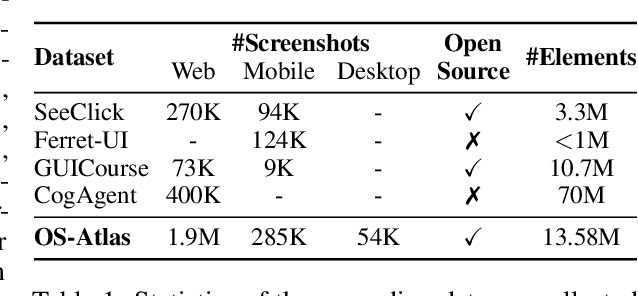
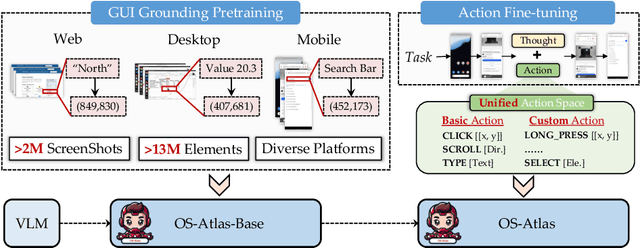
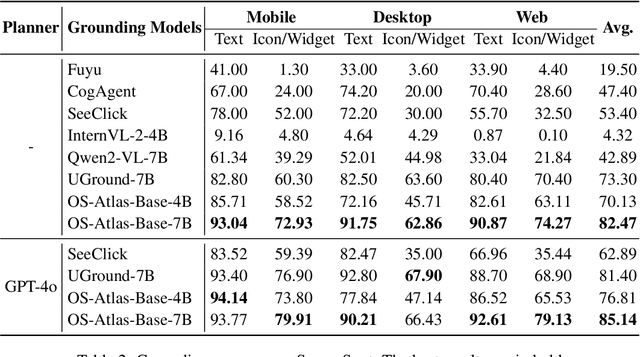
Abstract:Existing efforts in building GUI agents heavily rely on the availability of robust commercial Vision-Language Models (VLMs) such as GPT-4o and GeminiProVision. Practitioners are often reluctant to use open-source VLMs due to their significant performance lag compared to their closed-source counterparts, particularly in GUI grounding and Out-Of-Distribution (OOD) scenarios. To facilitate future research in this area, we developed OS-Atlas - a foundational GUI action model that excels at GUI grounding and OOD agentic tasks through innovations in both data and modeling. We have invested significant engineering effort in developing an open-source toolkit for synthesizing GUI grounding data across multiple platforms, including Windows, Linux, MacOS, Android, and the web. Leveraging this toolkit, we are releasing the largest open-source cross-platform GUI grounding corpus to date, which contains over 13 million GUI elements. This dataset, combined with innovations in model training, provides a solid foundation for OS-Atlas to understand GUI screenshots and generalize to unseen interfaces. Through extensive evaluation across six benchmarks spanning three different platforms (mobile, desktop, and web), OS-Atlas demonstrates significant performance improvements over previous state-of-the-art models. Our evaluation also uncovers valuable insights into continuously improving and scaling the agentic capabilities of open-source VLMs.
AgentStore: Scalable Integration of Heterogeneous Agents As Specialized Generalist Computer Assistant
Oct 24, 2024Abstract:Digital agents capable of automating complex computer tasks have attracted considerable attention due to their immense potential to enhance human-computer interaction. However, existing agent methods exhibit deficiencies in their generalization and specialization capabilities, especially in handling open-ended computer tasks in real-world environments. Inspired by the rich functionality of the App store, we present AgentStore, a scalable platform designed to dynamically integrate heterogeneous agents for automating computer tasks. AgentStore empowers users to integrate third-party agents, allowing the system to continuously enrich its capabilities and adapt to rapidly evolving operating systems. Additionally, we propose a novel core \textbf{MetaAgent} with the \textbf{AgentToken} strategy to efficiently manage diverse agents and utilize their specialized and generalist abilities for both domain-specific and system-wide tasks. Extensive experiments on three challenging benchmarks demonstrate that AgentStore surpasses the limitations of previous systems with narrow capabilities, particularly achieving a significant improvement from 11.21\% to 23.85\% on the OSWorld benchmark, more than doubling the previous results. Comprehensive quantitative and qualitative results further demonstrate AgentStore's ability to enhance agent systems in both generalization and specialization, underscoring its potential for developing the specialized generalist computer assistant. All our codes will be made publicly available in https://chengyou-jia.github.io/AgentStore-Home.
Interactive Evolution: A Neural-Symbolic Self-Training Framework For Large Language Models
Jun 17, 2024

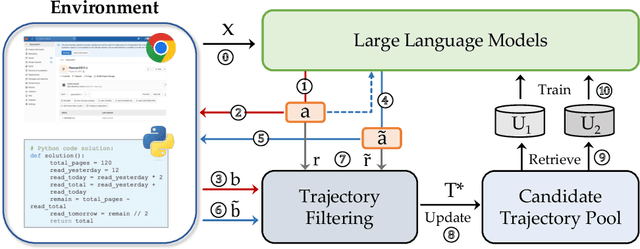
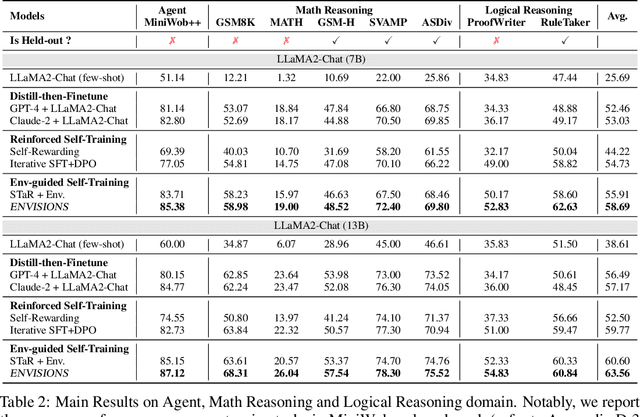
Abstract:One of the primary driving forces contributing to the superior performance of Large Language Models (LLMs) is the extensive availability of human-annotated natural language data, which is used for alignment fine-tuning. This inspired researchers to investigate self-training methods to mitigate the extensive reliance on human annotations. However, the current success of self-training has been primarily observed in natural language scenarios, rather than in the increasingly important neural-symbolic scenarios. To this end, we propose an environment-guided neural-symbolic self-training framework named ENVISIONS. It aims to overcome two main challenges: (1) the scarcity of symbolic data, and (2) the limited proficiency of LLMs in processing symbolic language. Extensive evaluations conducted on three distinct domains demonstrate the effectiveness of our approach. Additionally, we have conducted a comprehensive analysis to uncover the factors contributing to ENVISIONS's success, thereby offering valuable insights for future research in this area. Code will be available at \url{https://github.com/xufangzhi/ENVISIONS}.
Aggregation of Reasoning: A Hierarchical Framework for Enhancing Answer Selection in Large Language Models
May 21, 2024Abstract:Recent advancements in Chain-of-Thought prompting have facilitated significant breakthroughs for Large Language Models (LLMs) in complex reasoning tasks. Current research enhances the reasoning performance of LLMs by sampling multiple reasoning chains and ensembling based on the answer frequency. However, this approach fails in scenarios where the correct answers are in the minority. We identify this as a primary factor constraining the reasoning capabilities of LLMs, a limitation that cannot be resolved solely based on the predicted answers. To address this shortcoming, we introduce a hierarchical reasoning aggregation framework AoR (Aggregation of Reasoning), which selects answers based on the evaluation of reasoning chains. Additionally, AoR incorporates dynamic sampling, adjusting the number of reasoning chains in accordance with the complexity of the task. Experimental results on a series of complex reasoning tasks show that AoR outperforms prominent ensemble methods. Further analysis reveals that AoR not only adapts various LLMs but also achieves a superior performance ceiling when compared to current methods.
Structure-aware Fine-tuning for Code Pre-trained Models
Apr 11, 2024Abstract:Over the past few years, we have witnessed remarkable advancements in Code Pre-trained Models (CodePTMs). These models achieved excellent representation capabilities by designing structure-based pre-training tasks for code. However, how to enhance the absorption of structural knowledge when fine-tuning CodePTMs still remains a significant challenge. To fill this gap, in this paper, we present Structure-aware Fine-tuning (SAT), a novel structure-enhanced and plug-and-play fine-tuning method for CodePTMs. We first propose a structure loss to quantify the difference between the information learned by CodePTMs and the knowledge extracted from code structure. Specifically, we use the attention scores extracted from Transformer layer as the learned structural information, and the shortest path length between leaves in abstract syntax trees as the structural knowledge. Subsequently, multi-task learning is introduced to improve the performance of fine-tuning. Experiments conducted on four pre-trained models and two generation tasks demonstrate the effectiveness of our proposed method as a plug-and-play solution. Furthermore, we observed that SAT can benefit CodePTMs more with limited training data.
A Survey of Neural Code Intelligence: Paradigms, Advances and Beyond
Mar 21, 2024Abstract:Neural Code Intelligence -- leveraging deep learning to understand, generate, and optimize code -- holds immense potential for transformative impacts on the whole society. Bridging the gap between Natural Language and Programming Language, this domain has drawn significant attention from researchers in both research communities over the past few years. This survey presents a systematic and chronological review of the advancements in code intelligence, encompassing over 50 representative models and their variants, more than 20 categories of tasks, and an extensive coverage of over 680 related works. We follow the historical progression to trace the paradigm shifts across different research phases (e.g., from modeling code with recurrent neural networks to the era of Large Language Models). Concurrently, we highlight the major technical transitions in models, tasks, and evaluations spanning through different stages. For applications, we also observe a co-evolving shift. It spans from initial endeavors to tackling specific scenarios, through exploring a diverse array of tasks during its rapid expansion, to currently focusing on tackling increasingly complex and varied real-world challenges. Building on our examination of the developmental trajectories, we further investigate the emerging synergies between code intelligence and broader machine intelligence, uncovering new cross-domain opportunities and illustrating the substantial influence of code intelligence across various domains. Finally, we delve into both the opportunities and challenges associated with this field, alongside elucidating our insights on the most promising research directions. An ongoing, dynamically updated project and resources associated with this survey have been released at https://github.com/QiushiSun/NCISurvey.
KS-Lottery: Finding Certified Lottery Tickets for Multilingual Language Models
Feb 05, 2024Abstract:The lottery ticket hypothesis posits the existence of ``winning tickets'' within a randomly initialized neural network. Do winning tickets exist for LLMs in fine-tuning scenarios? How can we find such winning tickets? In this paper, we propose KS-Lottery, a method to identify a small subset of LLM parameters highly effective in multilingual fine-tuning. Our key idea is to use Kolmogorov-Smirnov Test to analyze the distribution shift of parameters before and after fine-tuning. We further theoretically prove that KS-Lottery can find the certified winning tickets in the embedding layer, fine-tuning on the found parameters is guaranteed to perform as well as full fine-tuning. Comparing KS-Lottery with other parameter-efficient tuning algorithms on translation tasks, the experimental results show that KS-Lottery finds a much smaller set of parameters for fine-tuning while achieving the comparable performance as full fine-tuning LLM. Surprisingly, we find that fine-tuning 18 tokens' embedding of LLaMA suffices to reach the fine-tuning translation performance. Code and model will be released to the public.
SeeClick: Harnessing GUI Grounding for Advanced Visual GUI Agents
Jan 17, 2024Abstract:Graphical User Interface (GUI) agents are designed to automate complex tasks on digital devices, such as smartphones and desktops. Most existing GUI agents interact with the environment through extracted structured data, which can be notably lengthy (e.g., HTML) and occasionally inaccessible (e.g., on desktops). To alleviate this issue, we propose a visual GUI agent -- SeeClick, which only relies on screenshots for task automation. In our preliminary study, we have discovered a key challenge in developing visual GUI agents: GUI grounding -- the capacity to accurately locate screen elements based on instructions. To tackle this challenge, we propose to enhance SeeClick with GUI grounding pre-training and devise a method to automate the curation of GUI grounding data. Along with the efforts above, we have also created ScreenSpot, the first realistic GUI grounding dataset that encompasses mobile, desktop, and web environments. After pre-training, SeeClick demonstrates significant improvement in ScreenSpot over various baselines. Moreover, comprehensive evaluations on three widely used benchmarks consistently support our finding that advancements in GUI grounding directly correlate with enhanced performance in downstream GUI agent tasks. The model, data and code are available at https://github.com/njucckevin/SeeClick.
 Add to Chrome
Add to Chrome Add to Firefox
Add to Firefox Add to Edge
Add to Edge